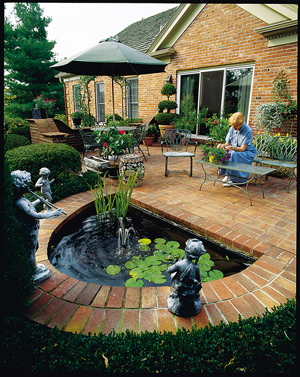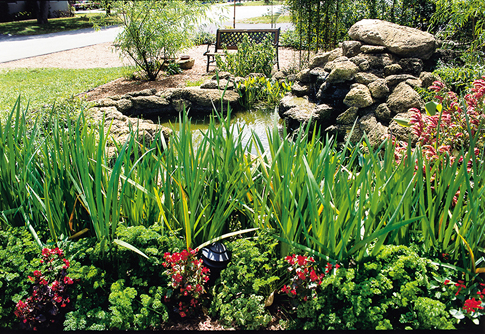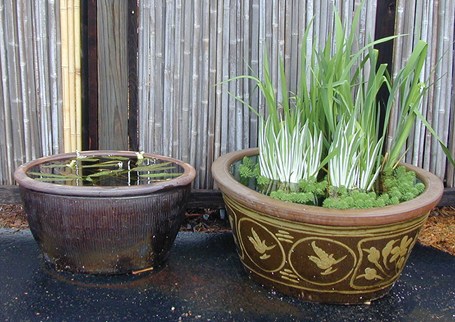A microclimate is a local atmospheric zone where the climate differs from the surrounding area. It refers to either a zone of many square miles or only a few square feet. Microclimates are why people living around a bay have more moderate temperatures than those inland and folks on opposite sides of a mountain have opposite weather. On even smaller geographic scales, they explain why a property’s low spot is cooler than the rest of the yard and why neighboring yards can have different temperatures.

Magic powers are required to change plant hardiness or heat zones, but with some knowledge you can analyze and adjust local microclimates. This has numerous applications for pond and garden design. Among others, they include site selection or orientation, enhanced potential for a property, increased aquatic plant sales, extended growing seasons for fish and plants and better customer satisfaction.
An understanding of different types of microclimates enables you to learn how to “push” hardiness zones by moderating the impacts of wind, cold and sun. Your company could extend the “enjoyment season” of a pond, plant, water feature or fish by two weeks or more every year. That’s a big deal whether you’re an aquatic plant supplier, an installer or anyone else in the pond business.
Microclimate Types
There are many factors that cause microclimates. The major ones affect the weather in your general area as well as on the location of your business property, project site and customers’ backyards. Once you understand their impacts it becomes possible to harness them to your advantage. They are interrelated and may affect each other.
Water bodies impact the surrounding climate, with larger bodies having greater impact. They are heat sinks, with a direct and strong effect on temperatures.
The sun is another obvious factor. What is important to climate and weather is the individual sunlight characteristics: amount, direction, strength, elevation and length of sun. Obviously they are also crucial for aquatic plant survival and growth, as well as water quality. Southerners may need to limit sun exposure in summer, while northerners want to extend it during most of the year.
Topography definitely affects microclimates. Generally, gardens and features on the south or west side of a hill are warmer because they are sunnier. They also have longer seasons. However, cold air travels just like water: it runs downhill. So lower spots are generally colder and depressions collect cold. Higher elevations are subject to greater winds, depending upon the exposure.Houses and buildings are often the strongest factors affecting a local property’s microclimate, especially when combined with surrounding paved areas. They form barriers that create protected areas away from prevailing winds. However, they may also form turbulent tunnels between structures or vortices around corners. Walls and paved areas usually absorb heat during the day that is radiated out at night. If the surface is impervious, water flowing off may accumulate, as can rain from downspouts.

Create Local Microclimates
Analyzing microclimates on an individual property will help you use the best orientation for your plant display and pond installation. (See sidebar.) It can also assist in optimizing an existing water garden. The information about specific sites can be applied to manipulate climatic conditions, which can lengthen the “enjoyment seasons,” add breadth to aquatic plant selections or reduce heat stress on fish and people during the peak of summer.

garden center. (Photo courtesy Paula Biles; Click Image to Expand)
Fences make excellent windbreaks, in addition to their many other benefits. They create sheltered zones with less drying of plants, pond surfaces and people. Board-on-board fences and hedges are better because they are permeable. Wind travels right over solid structures, creating eddies on the leeside and forming cold patches at the wall’s base. Before adding fences, determine prevailing winds and plan how their shadows may help or hinder aquatic plant growth or bloom cycles throughout the year.
Like imitation trees, overhead structures provide welcome shade. When wisely designed, they can alter the amount of sun and shade according to the seasons. You could create a patio covering with maximum shade in summer and almost full sun in winter. Overhangs could extend enough so they would also shade fish at desired times of the year. Do your homework on sun positions and carefully plan your pergola. The result may not be Stonehenge, but it too can align according to the sun’s annual path.
Solid surfaces are heat sinks. Their ability to store and release warmth can be used in a landscape design. Determine where you want to moderate temperatures (air or water) and then plan your use of brick, stone or concrete paving, pond edging and large rocks. In some warmer climates paving can make things too hot, so wood decking may be preferred to provide air movement and cooler temperatures, especially in summer.
The Bottom Line
Everyone complains about the weather. Now you can do something about it.


